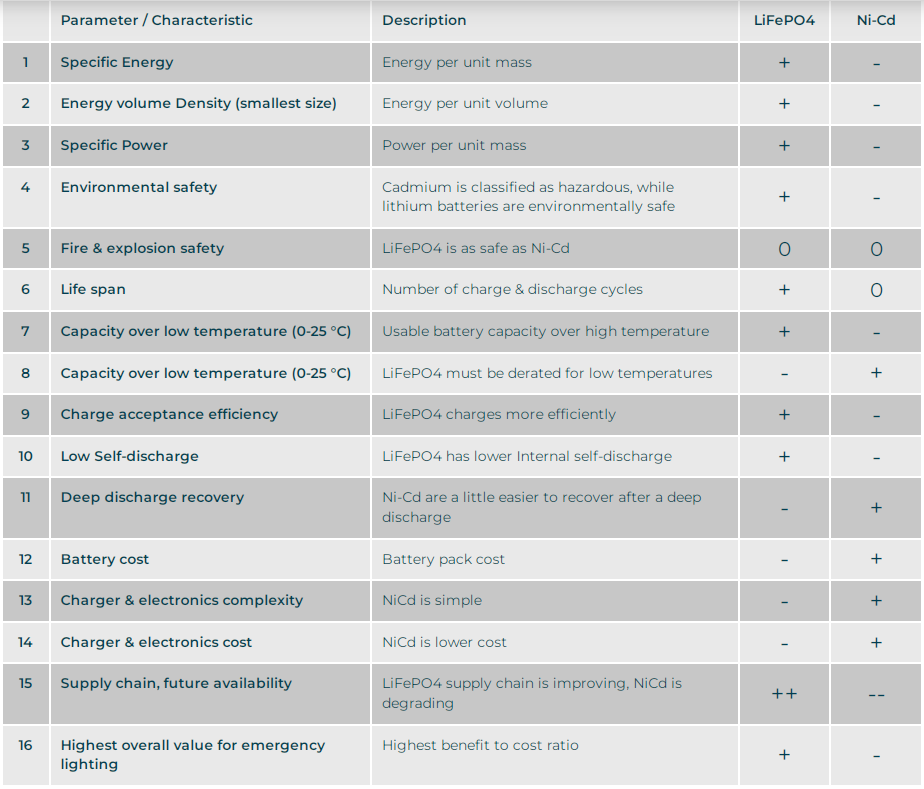Nov. 07, 2022
Electronic Components & Supplies
Ni-Cd Batteries vs. LiFePO4 Batteries for Emergency Lighting and Life Safety Products
Advantages (+) & disadvantages (-) & neutral (0) of LiFePO4 and Ni-Cd batteries

Specific Energy is a measure of the Energy per unit mass. LiFePO4 batteries have a greater energy capacity for a given mass than Ni-Cd batteries, which means LiFePO4 batteries weigh less than Ni-Cd batteries.
Energy volume Density is a measure of the Energy per unit volume. LiFePO4 batteries have a greater energy capacity for a given volume than Ni-Cd batteries, which means LiFePO4 batteries are smaller than Ni-Cd batteries. Currently, LiFePO4 batteries have almost twice the energy density than Ni-Cd batteries. This is one of the largest most favorable characteristics of LiFePO4 batteries as compared to Ni-Cd batteries.
Specific Power is a measure of the Power per unit mass. It is Power output divided by its mass, typically in units of W/kg. LiFePO4 batteries have a greater Specific Power capacity for a given mass than Ni-Cd batteries.
Environmental safety: NiCad batteries contain cadmium, which is a toxic heavy metal. Lithium batteries are environmentally safer as lithium is nonhazardous waste.
Fire & explosion safety is not an issue for LiFePO4 batteries. The LiFePO4 batteries are the safest type of Lithium batteries. UL924 requires that all LiFePO4 batteries meet rigorous UL testing for the individual cell and as a completed battery pack assembly. This UL approval further ensures that LiFePO4 batteries are safe and reliable.
Life span: Battery life is measured by number of full charge and discharge cycles, called cycle-life. LiFePO4 batteries have a cycle-life greater than 1000 cycles, while Ni-Cd batteries have a cycle-life of 500 cycles. Either way, cycle-life is not an issue since these batteries spend most of their entire life in charging mode in emergency LED drivers.
Capacity over high temperature (25-60 °C). LiFePO4 batteries do not need to be derated for high temperatures, whereas Ni-Cd batteries only achieve 60% of the nominal capacity at 60 °C. LiFePO4 batteries achieve almost 100% of the nominal capacity at 60 °C.
Suggested reading:Capacity over low temperature (0-25 °C). Both LiFePO4 batteries and Ni-Cd batteries must be derated at 0°C.Ni-Cd batteries only achieve about 80% of their nominal 25 °C charge-discharge capacity, while LiFePO4 batteries only achieve about 70% of their nominal 25 °C charge-discharge capacity.
Charge acceptance efficiency is a measure of how efficient the battery can be charged. At 25 °C LiFePO4 batteries achieve 96% efficiency, while Ni-Cd batteries only achieve about 90%.
Low Self-discharge. LiFePO4 batteries have a very low self-discharge rate that is half that of Ni-Cd batteries. This means that LiFePO4 batteries retain their charge twice as long as Ni-Cd batteries.
Deep discharge recovery. Ni-Cd batteries are a little easier to recover after a deep discharge should that ever be necessary.
Battery pack cost. In 2017, LiFePO4 batteries cost about 20% more than Ni-Cd batteries, based on $/Wh. That differential has narrowed some since LiFePO4 battery costs have decreased and Ni-Cd batteries have increased in cost. More importantly, most major Ni-Cd battery manufacturers have stopped manufacturing Ni-Cd batteries due to them being banned world-wide at a faster pace, and the cost of cadmium increasing.
Charger & electronics complexity: Ni-Cd batteries can be charged easily with a continuous constant current charger without monitoring their terminal voltage, and without internal circuitry. LiFePO4 batteries must use a smart charger that precisely monitors their terminal voltage to maintain it within safe levels. LiFePO4 batteries require internal circuitry to the battery pack to provide current sharing, overvoltage protection, temperature protection, and fuses for overcurrent protection.
Charger & electronics cost: The requirements for a smart charger and internal circuit in the battery pack result in higher Charger & electronics costs for LiFePO4 batteries.
Supply chain, future availability: The future availability of Ni-Cd batteries is becoming more volatile as the cost for LiFePO4 batteries decreases, and as the ban on Ni-Cd batteries spreads world-wide.
Highest overall value for Emergency Power Packs: LiFePO4 batteries increase the value of the emergency LED Driver. The LiFePO4 battery is a higher valued battery than the Ni-Cd battery. Today, LiFePO4 batteries are the optimum choice for Emergency LED Drivers.
Previous: What are the applications of the rectifier module?
Next: 3 Reasons Every Vehicle Should Use Mobile Data Tablet Tracking Software
Related Articles
If you are interested in sending in a Guest Blogger Submission,welcome to write for us!
All Comments ( 0 )